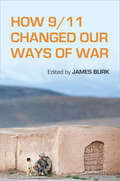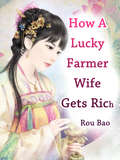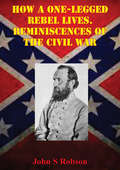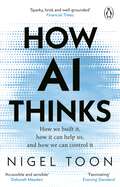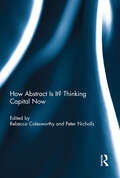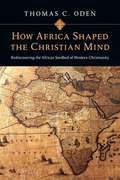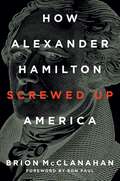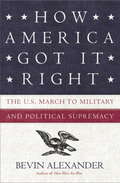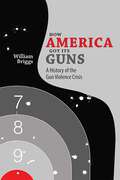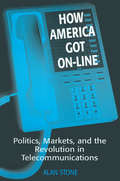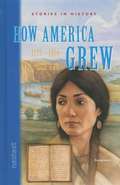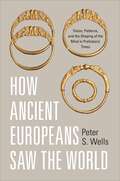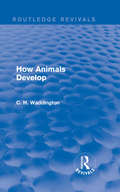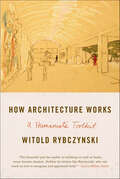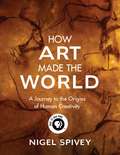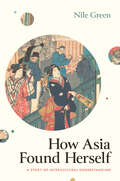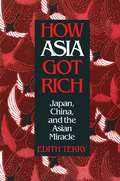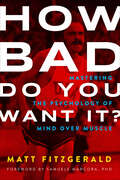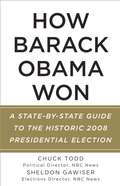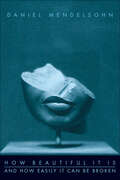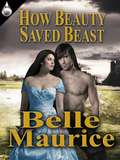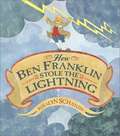- Table View
- List View
How 9/11 Changed Our Ways of War
by James BurkFollowing the 9/11 attacks, a war against al Qaeda by the U. S. and its liberal democratic allies was next to inevitable. But what kind of war would it be, how would it be fought, for how long, and what would it cost in lives and money? None of this was known at the time. What came to be known was that the old ways of war must changeOCobut how? Now, with over a decade of political decision-making and warfighting to analyze, "How 9/11 Changed Our Ways of War" addresses that question. In particular it assesses how well those ways of war, adapted to fight terrorism, affect our military capacity to protect "and" sustain liberal democratic values. The book pursues three themes: what shaped the strategic choice to go to war; what force was used to wage the war; and what resources were needed to carry on the fight? In each case, military effectiveness required new and strict limits on the justification, use, and support of force. How to identify and observe these limits is a matter debated by the various contributors. Their debate raises questions about waging future warsOCoincluding how to defend against and control the use of drones, cyber warfare, and targeted assassinations. The contributors include historians, political scientists, and sociologists; both academics and practitioners. "
How A Lucky Farmer Wife Gets Rich: Volume 1 (Volume 1 #1)
by Rou BaoAs soon as he opened his eyes, he became a little widow with a little bun that hugged her leg and called her mother.His family was scattered all over the place, and he suddenly felt that the Yali Mountain was very big.In order to raise the steamed buns, she had to rack her brains to earn a lot of money.But in the blink of an eye, his son had hugged the leg of a man he hadn't seen for long.
How A Lucky Farmer Wife Gets Rich: Volume 2 (Volume 2 #2)
by Rou BaoAs soon as he opened his eyes, he became a little widow with a little bun that hugged her leg and called her mother.His family was scattered all over the place, and he suddenly felt that the Yali Mountain was very big.In order to raise the steamed buns, she had to rack her brains to earn a lot of money.But in the blink of an eye, his son had hugged the leg of a man he hadn't seen for long.
How A Lucky Farmer Wife Gets Rich: Volume 3 (Volume 3 #3)
by Rou BaoAs soon as he opened his eyes, he became a little widow with a little bun that hugged her leg and called her mother.His family was scattered all over the place, and he suddenly felt that the Yali Mountain was very big.In order to raise the steamed buns, she had to rack her brains to earn a lot of money.But in the blink of an eye, his son had hugged the leg of a man he hadn't seen for long.
How A Lucky Farmer Wife Gets Rich: Volume 4 (Volume 4 #4)
by Rou BaoAs soon as he opened his eyes, he became a little widow with a little bun that hugged her leg and called her mother.His family was scattered all over the place, and he suddenly felt that the Yali Mountain was very big.In order to raise the steamed buns, she had to rack her brains to earn a lot of money.But in the blink of an eye, his son had hugged the leg of a man he hadn't seen for long.
How A One-Legged Rebel Lives. Reminiscences Of The Civil War: The Story Of The Campaigns Of Stonewall Jackson, Told By A High Private In The “Foot Cavalry”
by John S RobsonA veteran of the 52nd Virginia Regiment recounts his experiences under the great Stonewall Jackson in his Valley campaign and up until he lost his leg for the Southern cause at the battle of Cedar Creek.
How AI Thinks: How we built it, how it can help us, and how we can control it
by Nigel ToonTHE #2 TIMES BESTSELLER'Artificial intelligence is going to have a massive impact on everyone’s lives... an accessible and sensible read that helps demystify AI' Deborah Meaden, entrepreneur and star of Dragon's Den'Nigel Toon is a visionary leader in the field of artificial intelligence... a must-read' Marc Tremblay, Distinguished Engineer, MicrosoftThose who understand how AI thinks are about to win big.We are used to thinking of computers as being a step up from calculators - very good at storing information, and maybe even at playing a logical game like chess. But up to now they haven't been able to think in ways that are intuitive, or respond to questions as a human might. All that has changed, dramatically, in the past few years.Our search engines are becoming answer engines. Artificial intelligence is already revolutionising sectors from education to healthcare to the creative arts. But how does an AI understand sentiment or context? How does it play and win games that have an almost infinite number of moves? And how can we work with AI to produce insights and innovations that are beyond human capacity, from writing code in an instant to unfolding the elaborate 3D puzzles of proteins?We stand at the brink of a historic change that will disrupt society and at the same time create enormous opportunities for those who understand how AI thinks. Nigel Toon shows how we train AI to train itself, so that it can paint images that have never existed before or converse in any language. In doing so he reveals the strange and fascinating ways that humans think, too, as we learn how to live in a world shared by machine intelligences of our own creation.
How Abstract Is It? Thinking Capital Now
by Rebecca Colesworthy and Peter NichollsSince the start of the financial crisis in 2008, the notion that capitalism has become too abstract for all but the most rarefied specialists to understand has been widely presupposed. Yet even in academic circles, the question of abstraction itself – of what exactly abstraction is, and does, under financialisation – seems to have gone largely unexplored – or has it? By putting the question of abstraction centre stage, How Abstract Is It? Thinking Capital Now offers an indispensable counterpoint to the ‘economic turn’ in the humanities, bringing together leading literary and cultural critics in order to propose that we may know far more about capital’s myriad abstractions than we typically think we do. Through in-depth engagement with classic and cutting-edge theorists, agile analyses of recent Hollywood films, groundbreaking readings of David Foster Wallace’s sprawling, unfinished novel, The Pale King, and even original poems, the contributors here suggest that the machinations and costs of finance – as well as alternatives to it – may already be hiding in plain sight. This book was originally published as a special issue of Textual Practice.
How Africa Shaped the Christian Mind: Rediscovering the African Seedbed of Western Christianity (Early African Christianity Set)
by Thomas C. OdenAfrica has played a decisive role in the formation of Christian culture from its infancy. Some of the most decisive intellectual achievements of Christianity were explored and understood in Africa before they were in Europe. If this is so, why is Christianity so often perceived in Africa as a Western colonial import? How can Christians in Northern and sub-Saharan Africa, indeed how can Christians throughout the world, rediscover and learn from this ancient heritage? Theologian Thomas C. Oden offers a portrait that challenges prevailing notions of the intellectual development of Christianity from its early roots to its modern expressions. The pattern, he suggests, is not from north to south from Europe to Africa, but the other way around. He then makes an impassioned plea to uncover the hard data and study in depth the vital role that early African Christians played in developing the modern university, maturing Christian exegesis of Scripture, shaping early Christian dogma, modeling conciliar patterns of ecumenical decision-making, stimulating early monasticism, developing Neoplatonism, and refining rhetorical and dialectical skills. He calls for a wide-ranging research project to fill out the picture he sketches. It will require, he says, a generation of disciplined investigation, combining intensive language study with a risk-taking commitment to uncover the truth in potentially unreceptive environments. Oden envisions a dedicated consortium of scholars linked by computer technology and a common commitment that will seek to shape not only the scholar's understanding but the ordinary African Christian's self-perception.
How Alexander Hamilton Screwed Up America
by Ron Paul Brion McclanahanHe is the star of a hit Broadway musical, the face on the ten dollar bill, and a central figure among the founding fathers. But do you really know Alexander Hamilton? <P><P>Rather than lionize Hamilton, Americans should carefully consider his most significant and ultimately detrimental contribution to modern society: the shredding of the United States Constitution.Connecting the dots between Hamilton’s invention of implied powers in 1791 to transgender bathrooms and same-sex marriage two centuries later, Brion McClanahan shows the origins of our modern federal leviathan.
How America Got It Right
by Bevin AlexanderAt last, a historian tells the truth about America's role in the world--refuting the lies of anti-American propagandists.Left-wing critics--both at home and abroad--relish blasting our country for being the world's sole superpower, or even an "imperialist" power.But as acclaimed military historian Bevin Alexander shows in How America Got It Right, these criticisms are completely off the mark. Alexander reveals how the United States has done and continues to do exactly the right thing in military and foreign affairs. As the world's dominant political force and military power, he says, we are the only nation that will actually go into the world and strike down evil. And we must not shirk that responsibility--especially because we cannot rely on our so-called allies to defend our freedoms. Alexander tells the dramatic and sometimes surprising story of how, from the American Revolution to the War on Terror, America's core principles and ideals have shaped our march to economic, military, and political supremacy. How America Got It Right reveals:*How in the War on Terror we're simply repeating the process of World War II--going wherever we have to in the world to destroy those who threaten our safety*How unpatriotic critics of American foreign policy fail to understand the clear threats we now grapple with--but how our leaders get it*How America boldly--and correctly--asserted this nation's unique status to the world long before we had the military strength to back up our daring proclamations*How, at almost every turn, our leaders demonstrated remarkable foresight that enabled America to become the world's dominant power *How a policy of securing other people's freedom is in fact grounded in American tradition, not a dangerous departure from precedentAs Americans debate what our nation's role in world affairs should be, Alexander shows how--far from overreaching or bumbling into situations in which we shouldn't be involved--the United States has properly embraced its role as world leader. Covering more than two centuries of history, How America Got It Right refutes those critics who suggest that America has somehow gone off course or overextended itself.Indeed, according to Alexander, our government has got it right. America's critics have got it wrong, because what they are hoping for--peace without a price--will never come to pass.We saw early in our colonial history that--because of our isolation from Europe, and because of the immense wealth and bounty of our land--we had the opportunity to build the greatest, freest, and most prosperous nation ever to arise on earth. We spent the first century and a quarter of our independent existence in creating this great nation. But to protect this treasure, we found that we needed to establish the world's paramount military structure and become the world's preeminent political power. This book is the story of America's march to economic, military, and political supremacy, and the ideals that have guided us along the way. --From How America Got It RightFrom the Hardcover edition.
How America Got Its Guns: A History of the Gun Violence Crisis
by William BriggsIn the United States more than thirty thousand deaths each year can be attributed to firearms. This book on the history of guns in America examines the Second Amendment and the laws and court cases it has spawned. The author&’s thorough and objective account shows the complexities of the issue, which are so often reduced to bumper-sticker slogans, and suggests ways in which gun violence in this country can be reduced.Briggs profiles not only protagonists in the national gun debate but also ordinary people, showing the ways guns have become part of the lives of many Americans. Among them are gays and lesbians, women, competitive trapshooters, people in the gun-rights and gun-control trenches, the NRA&’s first female president, and the most successful gunsmith in American history.Balanced and painstakingly unbiased, Briggs&’s account provides the background needed to follow gun politics in America and to understand the gun culture in which we are likely to live for the foreseeable future.
How America Got On-line: Politics, Markets, and the Revolution in Telecommunication
by Alan StoneThe telecommunications industry is the fastest growing sector of the US economy. This interdisciplinary study of technopolitical economics traces the industry's evolution from the invention of the telephone to the development of hypercommunications. Primary focus is on AT&T and its rivals.
How America Grew: 1775-1914
by Nextext Staff Mcdougal-Littell StaffA collection of stories based on historical events in the history of the United States from 1775-1914, including the Lewis and Clark expedition, the Civil War, and the building of the Panama Canal.
How Ancient Europeans Saw the World: Vision, Patterns, and the Shaping of the Mind in Prehistoric Times
by Peter S. WellsA revolutionary approach to how we view Europe's prehistoric cultureThe peoples who inhabited Europe during the two millennia before the Roman conquests had established urban centers, large-scale production of goods such as pottery and iron tools, a money economy, and elaborate rituals and ceremonies. Yet as Peter Wells argues here, the visual world of these late prehistoric communities was profoundly different from those of ancient Rome's literate civilization and today's industrialized societies. Drawing on startling new research in neuroscience and cognitive psychology, Wells reconstructs how the peoples of pre-Roman Europe saw the world and their place in it. He sheds new light on how they communicated their thoughts, feelings, and visual perceptions through the everyday tools they shaped, the pottery and metal ornaments they decorated, and the arrangements of objects they made in their ritual places—and how these forms and patterns in turn shaped their experience.How Ancient Europeans Saw the World offers a completely new approach to the study of Bronze Age and Iron Age Europe, and represents a major challenge to existing views about prehistoric cultures. The book demonstrates why we cannot interpret the structures that Europe's pre-Roman inhabitants built in the landscape, the ways they arranged their settlements and burial sites, or the complex patterning of their art on the basis of what these things look like to us. Rather, we must view these objects and visual patterns as they were meant to be seen by the ancient peoples who fashioned them.
How Animals Develop: A Short Account Of The Science Of Embryology - Primary Source Edition (Routledge Revivals: Selected Works of C. H. Waddington)
by C. H. WaddingtonFirst published in 1935 (this edition in 1946), this short account of the science of embryology was the first book in English to provide a simple outline of the whole of this important subject. The study of development is perhaps the best method of approach to the most fundamental of all biological problems, the problem of how all the diverse activities are integrated so as to make up a complete individual organism. The book gives a short sketch of the general pattern on which all animals are built, but devotes more attention to the factors which cause the development of the elements in the pattern, and which then bring them into correct relations with one another. This volume is simply written in order to enable the general reader to understand the revolutionary advances made in the subject at that time.
How Architecture Works: A Humanist's Toolkit
by Witold RybczynskiAn essential toolkit for understanding architecture as both art form and the setting for our everyday livesWe spend most of our days and nights in buildings, living and working and sometimes playing. Buildings often overawe us with their beauty. Architecture is both setting for our everyday lives and public art form—but it remains mysterious to most of us. In How Architecture Works, Witold Rybczynski, one of our best, most stylish critics and winner of the Vincent Scully Prize for his architectural writing, answers our most fundamental questions about how good—and not-so-good—buildings are designed and constructed. Introducing the reader to the rich and varied world of modern architecture, he takes us behind the scenes, revealing how architects as different as Frank Gehry, Renzo Piano, and Robert A. M. Stern envision and create their designs. He teaches us how to "read" plans, how buildings respond to their settings, and how the smallest detail—of a stair balustrade, for instance—can convey an architect's vision. Ranging widely from a war memorial in London to an opera house in St. Petersburg, from the National Museum of African American History and Culture in Washington, D.C., to a famous architect's private retreat in downtown Princeton, How Architecture Works, explains the central elements that make up good building design. It is an enlightening humanist's toolkit for thinking about the built environment and seeing it afresh. "Architecture, if it is any good, speaks to all of us," Rybczynski writes. This revelatory book is his grand tour of architecture today.
How Art Made the World: A Journey to the Origins of Human Creativity
by Nigel SpiveyIn the late nineteenth century, the first discoveries of prehistoric painting were greeted with incredulity. How could there have been such deft and skillful artists in the world over 30,000 years ago? Noted art historian Nigel Spivey begins with this puzzle to explore the record of humanity’s artistic endeavors and their impact on our own development. Embarking with the motto, "Everyone is an artist,” Spivey takes us on a quest to find out when and how we humans began to explore the deepest questions of life, using visual artforms. With the help of vivid color illustrations of some of the world’s most moving and enduring works of art, Spivey shows how that art has been used as a means of mass persuasion, essential to the creation of hierarchical societies, and finally, the extent to which art has served as a mode of terror management in the face of our inevitable death. Packed with new insights into ancient wonders and fascinating stories from all around the globe, How Art Made the World is a compelling account of how humans made art and how art makes us human.
How Asia Found Herself: A Story of Intercultural Understanding
by Nile GreenA pioneering history of cross-cultural knowledge that exposes enduring fractures in unity across the world&’s largest continent The nineteenth century saw European empires build vast transport networks to maximize their profits from trade, and it saw Christian missionaries spread printing across Asia to bring Bibles to the colonized. The unintended consequence was an Asian communications revolution: the maritime public sphere expanded from Istanbul to Yokohama. From all corners of the continent, curious individuals confronted the challenges of studying each other&’s cultures by using the infrastructure of empire for their own exploratory ends. Whether in Japanese or Persian, Bengali or Arabic, they wrote travelogues, histories, and phrasebooks to chart the vastly different regions that European geographers labeled "Asia." Yet comprehension does not always keep pace with connection. Far from flowing smoothly, inter-Asian understanding faced obstacles of many kinds, especially on a landmass with so many scripts and languages. Here is the dramatic story of cross-cultural knowledge on the world&’s largest continent, exposing the roots of enduring fractures in Asian unity.
How Asia Got Rich: Japan, China and the Asian Miracle
by Edith TerryWithin a few short months in 1997, Asian economies that had been considered not only healthy but "miraculous" suddenly fell off a precipice as investors withdrew massively first from Asian currencies and, in rapid order, from equity markets across the region. On October 27 1997, the turmoil in Asian markets spooked Wall Street in the largest single-day decline in history, a drop of 550 points. It was predicted that the Asian crash could drive the US trade deficit from $191 billion to $300 billion by 1998, creating huge new tensions in relations with some of the largest US trading partners. These wrenching changes, following a generation of success, raise numerous questions about the steps that led to the crisis, its likely outcome and the limits and constraints of "Asian capitalism". Edith Terry presents a blow-by-blow account of the crisis, beginning with the 1996 collapse of the Bangkok Bank of Commerce. In her overview, she links the fall of the Asian miracle with the theme of globalization, arguing that the crisis demonstrates the urgency of dismantling restraints to trade, investment, and financial services, and that the United States should take leadership in pushing for new and sweeping reform through the World Trade Organization and in bilateral negotiations with its trading partners. The final section of the book deals with the rise of the "Asian miracle" - how the myth was created, who created it, why it succeeded for so long - and is informed by analysis of the Japanese prototype.
How Bad Do You Want It?: Mastering the Psychology of Mind over Muscle
by Matt FitzgeraldThe greatest athletic performances spring from the mind, not the body.Elite athletes have known this for decades and now science is learning why it’s true. In his fascinating new book How Bad Do You Want It?, coach Matt Fitzgerald examines more than a dozen pivotal races to discover the surprising ways elite athletes strengthen their mental toughness.Fitzgerald puts you into the pulse-pounding action of more than a dozen epic races from running, cycling, triathlon, XTERRA, and rowing with thrilling race reports and revealing post-race interviews with the elites. Their own words reinforce what the research has found: strong mental fitness lets us approach our true physical limits, giving us an edge over physically stronger competitors. Each chapter explores the how and why of an elite athlete’s transformative moment, revealing powerful new psychobiological principles you can practice to flex your own mental fitness.The new psychobiological model of endurance performance shows that the most important question in endurance sports is: how bad do you want it? Fitzgerald’s fascinating book will forever change how you answer this question and show you how to master the psychology of mind over muscle. These lessons will help you push back your limits and uncover your full potential.How Bad Do You Want It? reveals new psychobiological findings including:Mental toughness determines how close you can get to your physical limit.Bracing yourself for a tough race or workout can boost performance by 15% or more.Champions have learned how to give more of what they have.The only way to improve performance is by altering how you perceive effort.Choking under pressure is a form of self-consciousness.Your attitude in daily life is the same one you bring to sports.There’s no such thing as going as fast as you can—only going faster than before.The fastest racecourse is the one with the loudest spectators.Faith in your training is as important as the training itself.Athletes featured in How Bad Do You Want It?: Sammy Wanjiru, Jenny Simpson, Greg LeMond, Siri Lindley, Willie Stewart, Cadel Evans, Nathan Cohen and Joe Sullivan, Paula Newby-Fraser, Ryan Vail, Thomas Voeckler, Ned Overend, Steve Prefontaine, and last of all John “The Penguin” Bingham
How Barack Obama Won: A State-by-State Guide to the Historic 2008 Presidential Election
by Chuck Todd Sheldon GawiserThis detailed overview and analysis of the results of Barack Obama's historic 2008 presidential win gives us the inside state-by-state guide to how Obama achieved his victory, and allows us to see where the country stood four years ago. Although much has changed in the nearly four years since, How Barack Obama Won remains the essential guide to Obama's electoral strengths and offers important perspective on his 2012 bid. The votes in each state for Obama and McCain are broken down by percentage according to gender, age, race, party, religious affiliation, education, household income, size of city, and according to views about the most important issues (the economy, terrorism, Iraq, energy, healthcare), the future of the economy (worried, not worried) and the war in Iraq (approve, disapprove).
How Beautiful It Is And How Easily It Can Be Broken: Essays
by Daniel MendelsohnThe New York Times–bestselling critic uses his training as a classicist to tackle contemporary films, theater, literature, and more in 30 elegant essays.Whether he’s on Broadway or at the movies, considering a new bestseller or revisiting a literary classic, Daniel Mendelsohn’s judgments over the past fifteen years have provoked and dazzled with their deep erudition, disarming emotionality, and tart wit. Now How Beautiful It Is and How Easily It Can Be Broken reveals all at once the enormous stature of Mendelsohn’s achievement and demonstrates why he is considered one of our greatest critics. Writing with a lively intelligence and arresting originality, he brings his distinctive combination of scholarly rigor and conversational ease to bear across eras, cultures, and genres, from Roman games to video games.His interpretations of our most talked-about films—from the work of Pedro Almodóvar to Brokeback Mountain, from United 93 and World Trade Center to 300, Marie Antoinette, and The Hours—have sparked debate and changed the way we watch movies. Just as stunning and influential are his dispatches on theater and literature, from The Producers to Jeffrey Eugenides' Middlesex, from The Lovely Bones to the works of Harold Pinter. Together these thirty brilliant and engaging essays passionately articulate the themes that have made Daniel Mendelsohn a crucial voice in today’s cultural conversation: the aesthetic and indeed political dangers of imposing contemporary attitudes on the great classics; the ruinous effect of sentimentality on the national consciousness in the post-9/11 world; the vital importance of the great literature of the past for a meaningful life in the present.How Beautiful It Is and How Easily It Can Be Broken makes it clear that no other contemporary thinker is as engaged with as many aspects of our culture and its influences as Mendelsohn is, and no one practices the vanishing art of popular criticism with more acuity, humor, and feeling.Praise for How Beautiful It Is and How Easily It Can Be Broken “These essays richly repay the time readers spend in their company.” —Publishers Weekly (starred review)“Like fine banquet fare: Some items to be wolfed down, some savored slowly, some best stored in the fridge for a later day.” —Kirkus Reviews
How Beauty Saved Beast
by Belle MauriceThis adult fairy tale has all the classics - a curse, a beast, and the beautiful woman destined to save him . . . or does it?Cursed with insatiable lust and slowly transforming into a beast, the master of the castle sends his gamekeeper out to the nearby villages to choose girls to satisfy him. When the gamekeeper chooses her sister, Serena offers herself instead and is swept away to the castle, sure she will be driven mad by the Beast's demands.Except his demands are not so unwelcome, and Serena finds herself wanting to please him, confusing the Beast, and then terrifying him. If he gives her his heart, he will only lose it when he finally transforms and she abandons him. Why bring on more pain? She is there to be used, nothing more. But Serena refuses to be just an object for sexual satisfaction.She wants to be everything to the Beast. She wants him to love her.
How Ben Franklin Stole the Lightning
by Rosalyn SchanzerBen Franklin was the most famous American in the entire world during colonial times. No wonder! After all, the man could do just about anything. Why, he was an author and an athlete and a patriot and a scientist and an inventor to boot. He even found a way to steal the lightning right out of the sky.<P><P> Is such a thing possible? Is it. Take a look inside and find Ben busy at work on every spread. Then find out how he used his discovery about lightning to make people's lives safer.<P> In an inventive way, Rosalyn Schanzer brings us a brilliant and ever-curious American original.
